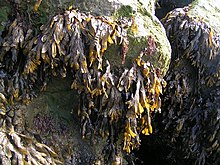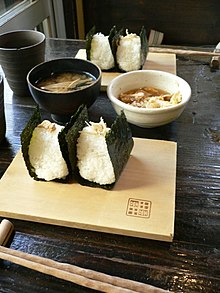seaweed
Kelp (short and seamanship: Tang ) refers mainly to the substrate sessile ( benthic ) Algae of sea coasts, the multi-cell , that are visible thalli own. They can reach sizes from a few millimeters up to 50 meters. This distinguishes these marine macroalgae or large algae from the microalgae, which are predominantly single-celled or only reach microscopic size and can form cotton-wool-like structures from thin threads. Seaweed is not a natural family group, but can be found among the green algae , red algae and brown algae . Some cyanobacteria can also be called seaweed.
description
Some kelp can resemble herbaceous land plants . The thallus (algae body) is anchored to the ground with a root-like adhesive organ ( rhizoid ). A stable, flexible stem ( cauloid ) arises from it . This carries leaf-like fronds ( phylloids ), which are used for photosynthesis . Gas-filled floats often keep the leaf organs close to the water surface. This structure is particularly found in the often large tangerines of the Laminariales . However, some marine macroalgae only form undifferentiated, low coatings on stones. All algae reproduce by spores in clusters of spores (Sori).
Occurrence

Seaweed thrives in the exposed area of the seashore, from the splash zone to the tidal zone to the sublittoral . It grows particularly lush on colder seashores, where nutrient-rich deep water rises. The lower limit for algae growth is approx. 0.1% of the incident surface light. The depth that can be reached depends on the turbidity and turbulence of the water. In the North Sea near Helgoland , seaweed can be found to a depth of 15 m below the low water line. In very clear water, the algae can also colonize deeper zones; they rarely penetrate to a depth of around 200 m.
An exception are some types of golf rod ( Sargassum ), which are not attached to the subsoil, but can freely swim over large areas in the open sea.
Seaweed is a major food source for sea urchins . Some starfish belong to the predators of the sea urchins. Since the species Pycnopodia helianthoides (sunflower starfish) is currently affected by mass extinction due to the overheating of its habitat as a result of climate change and a virus, sea urchins are losing an important predator and are spreading explosively in places, which in places leads to a decimation of stocks of seaweed.
use

Seaweed is an important food source used by coastal peoples. These include primarily Japan , but also Korea , Peru and also Ireland and the Atlantic coast of Canada . For example, nori is used to wrap sushi rolls.
Seaweed is also known for its extremely high iodine content of up to 6,000 milligrams per kg in dry weight (the daily iodine requirement is 0.2 milligrams), which if consumed uncontrolled can easily lead to a strong iodine oversupply. Dried seaweed is one of the foods rich in cadmium .
Seaweed is used in the production of the versatile carbohydrate alginate , as well as in fertilizer .
The Israeli biotechnology group BiolineRX has developed a gel based on seaweed that can be used in the treatment of heart attacks to protect the heart muscle tissue.
A plant tonic is made from seaweed for agriculture.
The earlier use of "kelp" as a building material for insulation of walls and roofing, as well as filling material for upholstered furniture, does not apply to seaweed, but on seagrasses ( Zostera ).
See also
literature
- Christian Wiencke, Kai Bischof [Ed.]: Seaweed Biology: Novel Insights into Ecophysiology, Ecology & Utilization. Springer, 2012. ISBN 978-3-642-28450-2 (print); ISBN 978-3-642-28451-9 (eBook)
swell
- Michael Guiry: The Seaweed Site: information on marine algae
- White, S. and M. Keleshian: A field guide to economically important seaweeds of northern New England . University of Maine / University of New Hampshire Sea Grant Marine Advisory Program. MSG-E-93-16, 1994.
Individual evidence
- ↑ a b c d Wolfram Braune: Marine algae. A color guide to the common benthic green, brown and red algae of the world's oceans . Ruggell: Gantner, 2008, ISBN 978-3-906166-69-8 , pp. 12-18.
- ↑ K. Lüning: Diving studies on the vertical distribution of the sublittoral Heligoland algae vegetation . Helgoland scientific marine survey. 21, 1970, p. 271.
- ↑ CD Harvell et al. a. (2019). Disease epidemic and a marine heat wave are associated with the continental-scale collapse of a pivotal predator (Pycnopodia helianthoides). Science Advances , 5 (1), eaau7042. https://doi.org/10.1126/sciadv.aau7042
- ↑ Can Seaweed Mend a Broken Heart? April 7, 2008.


